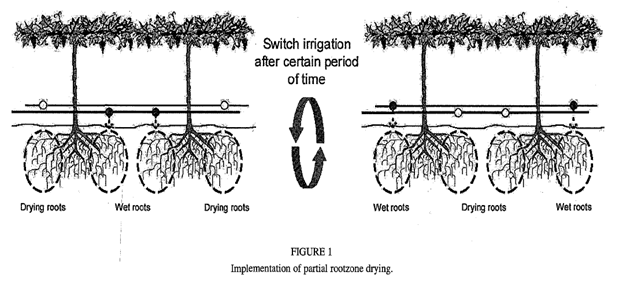Author: Rajni Sinha
Department of horticulture (Fruit and Fruit Tech.)B.A.U., Sabour, Bhagalpur, Bihar,India,813210
E-mail: rajnisinha19h@gmail.com
Partial root zone drying (PRD) , a new irrigation strategy that sustains for the industry which faces a number of converging pressures associated with climate change, population growth and deteriorating agricultural practices by reducing water consumption.PRD is an irrigation management technique designed to reduce water use without a decline in yield, and tends to increase in water use efficiency (WUE). It requires the frequent irrigation of approximately half of the root system while the other half is left to dry (Fig. 1). After a certain period of time the 'wet' and 'dry , zones are alternated, allowing the former 'wet' zone to dry while the 'dry' zone is irrigated (Dry & Loveys, 1999). The alternation of 'wet' and 'dry' zones would typically occur on a seven-to fifteen-days intervals depending on the type of soil and climatic conditions. Soil moisture content is monitored by means of the soil moisture sensor system. This technique is highly appreciated in many crops like orange trees , pomegranate,grape, apple, mandarin, mango, cotton, okra ,maize and Olive .This technique is applicable to a high value crop that occurs in drought or low water condition.

Source : Toit et al.,2003
Physiology behind PRD
The PRD system relies on root to shoot signals emerging from the roots in response to low soil water potentials within the 'dry' zone. It has been found that drying roots originates abscisic acid (ABA), which precisely involved in regulating stomatal curvature thereby conserving water by reducing transpiration from leaf tissues. As soil dries, the transport of ABA in the xylem increases and this may also be associated with an alteration of pH and thus induces a number of physiological response inside the leaf such as stomatal closure , reduced mesophyll conductance , slower respiration and enhanced expression of antioxidants to conserve water and protect the photosynthetic physiology.
Effect of PBD
1. Reduces wastage of water upto 45-50 % and improves the efficiency of irrigation by deduction in leaf water potential and stomatal conductance.
2. Controls vegetative growth specially of Lateral shoot and thus reduces canopy density and
leaf area.
3. Posses no alteration in yield but enhanced fruit quality in comparison to plants that received full irrigation to the entire root system.
4. PRD cause decrease in nitrogen assimilation which is measured by the activity of NR (Nitrate Reductase). The PRD reduces NR activities that may be influenced by either a reduced assimilation rate due to stomatal closure, a reduction in nitrogen absorption by roots and/or a hormonal influence leads to shorter shoot growth .
5. Improves the long-term stability of wine colour in grapes due to increase in concentration of anthocyanins in berry skins and enhance the quality of wines by producing an important volatile aroma compounds “norisoprenoids”.
6.Involves in primary metabolism like malate and hexose accumulation in plant system under alternate drying and wetting irrigation technique
7. Enhances secondary metabolite production like anthocyanin , phenol, carotenoid levels , glycosylated C13- norisoprenoid compounds in fruit crops .
References:
1. P.G. du Toit, P.R. Dry and B.R. Loveys.,2003. A Preliminary Investigation on Partial Rootzone Drying (PRD) Effects onGrapevine Performance, Nitrogen Assimilation and Berry Composition. s. Afr. J. Enol. Vitic., Vol. 24, No.2
2. Dry, P. R. & Loveys, B. R., 1999. Grapevine shoot growth and stomatal conductance
are reduced when part of the root system is dried. Vitis 38, 151-156.
About Author / Additional Info:
I am a Ph.D student in fruit science department of BAC, Sabour